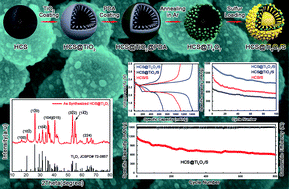Facile synthesis of Ti4O7 on hollow carbon spheres with enhanced polysulfide binding for high-performance lithium–sulfur batteries†
Abstract
As the next generation of electrochemical energy storage devices, lithium sulfur (Li–S) batteries have many advantages such as high theoretical specific capacity (1675 mAh g−1) and energy density (2600 kw h kg−1), non-toxicity and low cost. However, the poor electrical conductivity of sulfur cathodes and the shuttling effect of lithium polysulfides during cycling strongly hinder the commercial application of Li–S batteries. In this study, Magnéli phase Ti4O7 nanoparticles were successfully prepared on the surface of hollow carbon spheres (HCS) through a carbothermal reduction reaction. The synthesized HCS@Ti4O7 with a mesoporous structure exhibited a uniform spherical morphology with a large specific surface area (512 m2 g−1) and the pore volume of 0.58 cm3 g−1. The introduction of a polydopamine (PDA) layer during the preparation was confirmed to effectively inhibit the grain coarsening of Ti4O7. Moreover, the high content of sulfur loading (70%) did not affect the morphology of HCS@Ti4O7, which suggested its stable architecture. The assembled coin cells exhibited the superior reversible capacity of 1427 mAh g−1 at 0.1C and favorable cycling stability from 1168 mAh g−1 to 601 mAh g−1 after 800 cycles at 0.5C with the capacity decay rate of only 0.06% per cycle. This excellent performance and stability were attributed to the strong chemical binding effects of Ti4O7 on lithium polysulfides and the stable morphology maintenance during cycling. This study provides a novel conception to design and synthesize nanocomposites between reduced metal oxides and carbon with uniform and stable mesoporous structures for high-performance Li–S batteries.



 Please wait while we load your content...
Please wait while we load your content...